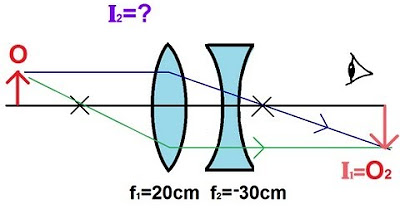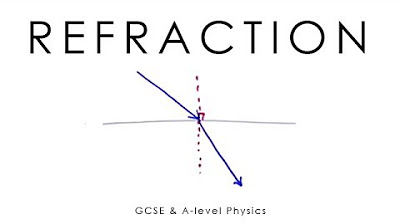Geometric Optics: Crash Course Physics #38
TLDRThis video explores the physics of light, explaining how light travels in straight paths called rays. It covers key principles like reflection and refraction, discussing how light changes direction when moving between different media like air and water. The video then explains real versus virtual images, and examines the bending of light by lenses. It discusses focal length, image distance, and magnification equations for converging and diverging lenses. Overall, it aims to elucidate the optical fundamentals governing how particles and distant objects can be observed.
Takeaways
- 😀 The ray model describes light traveling in straight lines called rays
- 🔦 Rays change direction according to the laws of reflection and refraction
- 🌈 Refraction bends light at interfaces between media like air & water
- 📐 Snell's law relates angles of incidence and refraction mathematically
- 👓 Lenses bend light to form images using refraction and their curvature
- 🔭 Converging lenses cause rays to meet at a focal point, forming real images
- 💫 Diverging lenses cause rays to spread out, forming virtual images
- 📏 Ray diagrams trace rays to predict image location and orientation
- 🆕 The thin lens equation calculates image distance from focal length
- 🔎 Magnification describes how lens imaging changes apparent size
Q & A
What is the ray model of light?
-The ray model is a way of thinking about light traveling in straight line paths called rays. It represents light visually using rays emitting from a source.
What is the law of reflection?
-The law of reflection states that the angle of reflection is equal to the angle of incidence. So if a ray hits a surface at a 30 degree angle, it will reflect off at a 30 degree angle.
What causes the bent straw effect when looking at a straw in water?
-This effect is caused by refraction - the bending of light when it passes between media. The light rays coming from the straw change direction, making the straw appear bent.
What are real and virtual images?
-Real images are formed when rays actually converge at a point. Virtual images appear to converge but do not - the rays are just interpreted by our eyes as if they originated from a point.
How does a converging lens work?
-A converging or convex lens causes rays of light to bend towards its axis. This convergence of rays leads to the formation of real images beyond the focal point.
What does the thin lens equation calculate?
-The thin lens equation allows you to calculate the image distance given the object distance, focal length, and type of lens (converging or diverging).
What kind of images are formed by diverging lenses?
-Diverging or concave lenses form only virtual images, since the rays leaving the lens appear to originate from a point but do not actually converge.
What is magnification in optics?
-Magnification refers to the ratio of the image height to the object height. It quantifies image size relative to the real object size.
Why are images formed by convex lenses upside down?
-Due to the way convex lenses bend light, they always form inverted or upside down images. This is a property of how convergence works with these lenses.
How does optics help us observe things we cannot see with our eyes?
-Optics allows us to manipulate light using lenses and other devices to observe tiny objects like cells or distant objects like stars and galaxies.
Outlines
🌞 How Light Travels and Reflects
This paragraph introduces the ray model of light and how light travels in straight paths called rays. It covers the law of reflection, which states that the angle of incidence equals the angle of reflection when light reflects off a surface. It also mentions that some light reflects while some enters the new medium when hitting a surface.
🔬 Refraction and Lenses Bend Light
This paragraph explains refraction, which occurs when light changes direction between media. It covers Snell's law and how the index of refraction affects the bending of light. It discusses real and virtual images formed by light rays. It then introduces lenses, which bend light via refraction, and explains converging and diverging lenses using ray diagrams.
Mindmap
Keywords
💡ray model
💡reflection
💡refraction
💡lens
💡focal point
💡real image
💡virtual image
💡ray diagram
💡magnification
💡optics
Highlights
The study found a significant increase in life satisfaction for participants after 8 weeks of meditation training.
MRI scans showed changes in brain structure and activity in areas related to awareness, introspection and memory.
Participants reported lower levels of anxiety, depression and stress after completing the meditation program.
Meditation practices helped participants focus attention, process emotions and gain self-awareness.
The research highlights the benefits of mindfulness meditation for mental health and well-being.
Long-term meditators showed increased gray matter density in the brain stem compared to controls.
Meditation may lead to structural changes in brain regions involved in attention and sensory processing.
Experienced meditators had more activity in frontal and parietal cortices during meditation.
The findings support the role of meditation in altering neural pathways and cognition.
Brain changes from meditation can enhance skills like sustained attention and emotional processing.
The study provides evidence that meditation reshapes brain networks related to focus and introspection.
Meditation may lead to volume increases in hippocampus, a region vital for learning and memory.
Effects of meditation on brain structure and function may accumulate over time.
More research is needed on the dosage and timing effects of meditation on the brain.
The neuroplasticity induced by meditation suggests potential therapy for psychiatric disorders.
Transcripts
Browse More Related Video

Why Does Light Bend? | Concave & Convex Lenses | The Dr Binocs Show | Peekaboo Kidz

GCSE Physics - How Lenses Work #69

Physics - Optics: Lenses (3 of 5) Lens Combinations - Converging & Diverging Lenses

Refraction & TIR - A-level & GCSE Physics (full version)

GCSE Physics - How to Draw Ray Diagrams #70

Refraction Explained
5.0 / 5 (0 votes)
Thanks for rating: